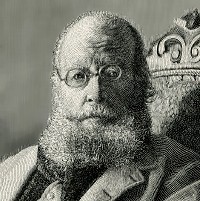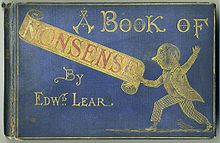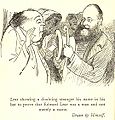Edward Lear: Difference between revisions
No edit summary |
Undid revision 492230098 by 86.178.111.1 (talk) |
||
| Line 70: | Line 70: | ||
Throughout his life he continued to paint seriously. He had a lifelong ambition to illustrate [[Alfred Tennyson|Tennyson]]'s poems; near the end of his life a volume with a small number of illustrations was published, but his vision for the work was never realised. |
Throughout his life he continued to paint seriously. He had a lifelong ambition to illustrate [[Alfred Tennyson|Tennyson]]'s poems; near the end of his life a volume with a small number of illustrations was published, but his vision for the work was never realised. |
||
==Author== |
|||
==Author==way to go edward lear was a good man my name is fathma ali and shaila uddin im in year 7 leeds eastacademy--[[Special:Contributions/86.178.111.1|86.178.111.1]] ([[User talk:86.178.111.1|talk]]) 17:28, 12 May 2012 (UTC)--[[Special:Contributions/86.178.111.1|86.178.111.1]] ([[User talk:86.178.111.1|talk]]) 17:28, 12 May 2012 (UTC)[[File:''Example.jpg''àĊğĀ]][[File:Lear petra wadi bushes sketch 1858.jpg|thumb|left|A study of bushes in a [[wadi]] at [[Petra]], 1858]] |
|||
[[File:Lear petra wadi bushes sketch 1858.jpg|thumb|left|A study of bushes in a [[wadi]] at [[Petra]], 1858]] |
|||
In 1846 Lear published ''[[:s:A Book of Nonsense|A Book of Nonsense]]'', a volume of limericks that went through three editions and helped popularise the form. In 1865 ''The History of the Seven Families of the Lake Pipple-Popple'' was published, and in 1867 his most famous piece of [[nonsense]], ''[[The Owl and the Pussycat]]'', which he wrote for the children of his patron [[Edward Stanley, 13th Earl of Derby]]. Many other works followed. |
In 1846 Lear published ''[[:s:A Book of Nonsense|A Book of Nonsense]]'', a volume of limericks that went through three editions and helped popularise the form. In 1865 ''The History of the Seven Families of the Lake Pipple-Popple'' was published, and in 1867 his most famous piece of [[nonsense]], ''[[The Owl and the Pussycat]]'', which he wrote for the children of his patron [[Edward Stanley, 13th Earl of Derby]]. Many other works followed. |
||
Revision as of 18:10, 12 May 2012
Edward Lear | |
|---|---|
 Edward Lear, ca. 1888d | |
| Born | 12 May 1812 Holloway, Middlesex, UK |
| Died | 29 January 1888 (aged 75) Sanremo, Liguria, Italy |
| Occupation | Illustrator, Writer (poet) |
| Nationality | a |
| Period | 19th century |
| Genre | Children's literature |
| Literary movement | Literary nonsense |
Edward Lear (12 May 1812 – 29 January 1888) was a British artist, illustrator, author, and poet, renowned today primarily for his literary nonsense, in poetry and prose, and especially his limericks, a form that he popularised.
Biography
Lear was born into a middle-class family in the village of Holloway, the 21st child of Ann and Jeremiah Lear. He was raised by his eldest sister, also named Ann, 21 years his senior. Ann doted on Lear and continued to mother him until her death, when Lear was almost 50 years of age.[1] Due to the family's failing financial fortune, at age four he and his sister had to leave the family home and set up house together.
Lear suffered from health problems. From the age of six he suffered frequent grand mal epileptic seizures, and bronchitis, asthma, and in later life, partial blindness. Lear experienced his first seizure at a fair near Highgate with his father. The event scared and embarrassed him. Lear felt lifelong guilt and shame for his epileptic condition. His adult diaries indicate that he always sensed the onset of a seizure in time to remove himself from public view. How Lear was able to anticipate them is not known, but many people with epilepsy report a ringing in their ears (tinnitus) or an aura before the onset of a seizure. In Lear's time epilepsy was believed to be associated with demonic possession, which contributed to his feelings of guilt and loneliness. When Lear was about seven he began to show signs of depression, possibly due to the constant instability of his childhood. He suffered from periods of severe depression which he referred to as "the Morbids." [2]

Lear travelled widely throughout his life and eventually settled in Sanremo, on his beloved Mediterranean coast, in the 1870s, at a villa he named "Villa Tennyson." The closest he came to marriage was two proposals, both to the same woman 46 years his junior, which were not accepted. For companions he relied instead on a circle of friends and correspondents, and especially, in later life, on his Albanian Souliote chef, Giorgis, a faithful friend and, as Lear complained, a thoroughly unsatisfactory chef.[3] Another trusted companion in Sanremo was his cat, Foss, who died in 1886 and was buried with some ceremony in a garden at Villa Tennyson. After a long decline in his health, Lear died at his villa in 1888, of the heart disease from which he had suffered since at least 1870. Lear's funeral was said to be a sad, lonely affair by the wife of Dr. Hassall, Lear's physician, not one of Lear's many lifelong friends being able to attend.[4]
Lear is buried in the Foce Cemetery in Sanremo. On his headstone are inscribed these lines about Mount Tomohrit (Albania) from Tennyson's To E.L. [Edward Lear], On His Travels in Greece:
Tomohrit, Athos, all things fair.
With such a pencil, such a pen.
You shadow forth to distant men,
I read and felt that I was there.[5]
Edward Lear was known to introduce himself with his long name: "Mr Abebika kratoponoko Prizzikalo Kattefello Ablegorabalus Ableborinto phashyph" or "Chakonoton the Cozovex Dossi Fossi Sini Tomentilla Coronilla Polentilla Battledore & Shuttlecock Derry down Derry Dumps" which he based on Aldiborontiphoskyphorniostikos.[6]
The centenary of his death was marked in Britain with a set of Royal Mail stamps in 1988 and an exhibition at the Royal Academy. Lear's birthplace area is now badged with a plaque at Bowman's Mews, Islington in London and his bicentenary in 2012 celebrated with a range of events, exhibitions and lectures in venues across the world including an International Owl and Pussycat Day on his birthday. On this day he was honoured by a Google Doodle depicting the Owl and the Pussycat dancing.[7]
Artist

Lear was already drawing "for bread and cheese" by the time he was aged 16 and soon developed into a serious "ornithological draughtsman" employed by the Zoological Society and then from 1832 to 1836 by the Earl of Derby, who had a private menagerie. His first publication, published when he was 19, was Illustrations of the Family of Psittacidae, or Parrots in 1830. His paintings were well received and he was favourably compared with Audubon.
Among other trips, he visited Greece and Egypt in 1848–49, and toured the length of India and Ceylon (Sri Lanka) in 1873–75. While travelling he produced large quantities of coloured wash drawings in a distinctive style, which he worked up back in his studio into oils and watercolours, as well as prints for his books.[8] His landscape style often shows views with strong sunlight, with intense contrasts of colour.
Throughout his life he continued to paint seriously. He had a lifelong ambition to illustrate Tennyson's poems; near the end of his life a volume with a small number of illustrations was published, but his vision for the work was never realised.
Author

In 1846 Lear published A Book of Nonsense, a volume of limericks that went through three editions and helped popularise the form. In 1865 The History of the Seven Families of the Lake Pipple-Popple was published, and in 1867 his most famous piece of nonsense, The Owl and the Pussycat, which he wrote for the children of his patron Edward Stanley, 13th Earl of Derby. Many other works followed.
Lear's nonsense books were quite popular during his lifetime, but a rumour circulated that "Edward Lear" was merely a pseudonym, and the books' true author was the man to whom Lear had dedicated the works, his patron the Earl of Derby. Supporters of this rumour offered as evidence the facts that both men were named Edward, and that "Lear" is an anagram of "Earl".[9]
Lear's nonsense works are distinguished by a facility of verbal invention and a poet's delight in the sounds of words, both real and imaginary. A stuffed rhinoceros becomes a "diaphanous doorscraper". A "blue Boss-Woss" plunges into "a perpendicular, spicular, orbicular, quadrangular, circular depth of soft mud". His heroes are Quangle-Wangles, Pobbles, and Jumblies. His most famous piece of verbal invention, a "runcible spoon" occurs in the closing lines of The Owl and the Pussycat, and is now found in many English dictionaries:

They dined on mince, and slices of quince
Which they ate with a runcible spoon;
And hand in hand, on the edge of the sand,
They danced by the light of the moon,
The moon,
The moon,
They danced by the light of the moon.
Though famous for his neologisms, Lear employed a number of other devices in his works in order to defy reader expectations. For example, "Cold Are The Crabs",[10] adheres to the sonnet tradition until the dramatically foreshortened last line.
Limericks are invariably typeset as four plus one lines today, but Lear's limericks were published in a variety of formats. It appears that Lear wrote them in manuscript in as many lines as there was room for beneath the picture. In the first three editions most are typeset as, respectively, two, five, and three lines. The cover of one edition[11] bears an entire limerick typeset in two lines:
There was an Old Derry down Derry, who loved to see little folks merry;
So he made them a book, and with laughter they shook at the fun of that Derry down Derry.
In Lear's limericks the first and last lines usually end with the same word rather than rhyming. For the most part they are truly nonsensical and devoid of any punch line or point. They are completely free of the off-colour humour with which the verse form is now associated. A typical thematic element is the presence of a callous and critical "they". An example of a typical Lear limerick:
There was an Old Man of Aôsta,
Who possessed a large Cow, but he lost her;
But they said, 'Don't you see,
she has rushed up a tree?
You invidious Old Man of Aôsta!'
Lear's self-portrait in verse, How Pleasant to know Mr. Lear, closes with this stanza, a reference to his own mortality:
He reads but he cannot speak Spanish,
He cannot abide ginger-beer;
Ere the days of his pilgrimage vanish,
How pleasant to know Mr. Lear!
Five of Lear's limericks from the Book of Nonsense, in the 1946 Italian translation by Carlo Izzo, were set to music for choir a cappella by Goffredo Petrassi, in 1952.
Works
- Mount Timohorit, Albania (1848)
- Illustrations of the Family of the Psittacidae, or Parrots (1832)
- Tortoises, Terrapins, and Turtles by J.E. Gray
- Views in Rome and its Environs (1841)
- Gleanings from the Menagerie at Knowsley Hall (1846)
- Book of Nonsense (1846)
- Journal of a Landscape Painter in Greece and Albania (1851)
- Journal of a Landscape Painter in Corsica (1870)
- Nonsense Songs and Stories (1871)
- More Nonsense Songs, Pictures, etc. (1872)
- Laughable Lyrics (1877)
- Nonsense Alphabets
- Nonsense Botany (1888)
- Tennyson's Poems, illustrated by Lear (1889)
- Facsimile of a Nonsense Alphabet (1849, but not published until 1926)
- The Scroobious Pip, unfinished at his death, but completed by Ogden Nash and illustrated by Nancy Ekholm Burkert (1968)
- The Quangle-Wangle's Hat (unknown)
- Edward Lear's Parrots by Brian Reade, Duckworth (1949), including 12 coloured plates from Lear's Psittacidae
- The 1970 Saturday morning cartoon Tomfoolery, based on the works of Lear and Lewis Carroll
Illustrations
-
Ara macao from his first book, 1830
-
Eagle Owl, Edward Lear, 1837
-
Another Edward Lear owl, in his more familiar style
-
Lear self portrait, illustrating a real incident when he encountered a stranger who claimed that "Edward Lear" was merely a pseudonym. Lear (on the right) is showing the stranger (left) the inside of his hat, with his name in the lining.
-
Illustration by Edward Lear for There was a Young Lady of Hull
See also
- A Beach Full of Shells, the 20th album by Musician Al Stewart pays tribute in the song “Mr. Lear”, celebrating Foss and many events from Lear’s life.
- Lear's Macaw
- List of wildlife artists
References
- ^ Holbrook, Jackson (ed). The Complete Nonsense of Edward Lear. Dover Publications, 1951. Page xii.
- ^ Lear, Edward (2002). The Complete Verse and Other Nonsense. New York: Penguin Books. pp. 19–20. ISBN 0-14-200227-5.
{{cite book}}: Cite has empty unknown parameter:|coauthors=(help) - ^ Levi, Peter. Edward Lear, a Biography.
- ^ Strachie, Lady Constance Braham. Later Letters of Edward Lear: Author of "The Book of Nonsense." 1911: Duffield and Company. P. 332
- ^ Oxford Dictionary of National Biography. Subscription required.
- ^ Pendlebury, Kathleen Sarah (November 2007). "Reading Nonsense: A Journey through the writing of Edward Lear" (PDF). A thesis submitted in fulfilment of the Requirements for the degree of MASTERS OF ARTS of RHODES UNIVERSITY. RHODES UNIVERSITY. pp. 20–21. Retrieved 14 February 2011.
- ^ "International Owl & Pussycat Day, 12 May | Just another WordPress.com site". Teachingnonsenseinschools.wordpress.com. Retrieved 2012-01-16.
- ^ Andrew Wilton & Anne Lyles, The Great Age of British Watercolours (1750–1880), p. 318, 1993, Prestel, ISBN 3-7913-1254-5
- ^ Lear, Edward (1894). "Introduction". More Nonsense Pictures, Rhymes, Botany, etc.
- ^ "Cold Are The Crabs". Ingeb.org. Retrieved 2012-01-16.
- ^ "Edward Lear, A Book of Nonsense". Nonsenselit.org. Retrieved 2012-01-16.
External links
- Works by Edward Lear at Project Gutenberg
- Edward Lear's Books of Nonsense
- Android app of Edward Lear limericks
- Scans of illustrations from the Nonsense series of books
- Edward Lear Home Page at nonsenselit.org
- Reelyredd's Poetry Pages The Daddylonglegs and The Fly (audio file)
- The Owl and the Pussy-cat translation project Available in more than 100 languages
- "Edward Lear: The Corfu Years" ed. Philip Sherrard
- Tales of Curiosity a short video, images and text about Lear and his cat Foss
- Music compositions to the nonsense of Edward Lear
- Calico Pie and Other Poems of Edward Lear set to Music
- The Owl and the Pussy-cat, animated
- Ten Poems by Edward Lear in Print Ready Booklet pdf
- International Owl and Pussycat Day teaching ideas – Edward Lear's bicentenary
- Blog of Bosh bicentenary information
- Royal Mail Edward Lear death centenary stamp issue 1988
- Full text, images, and covers of several of Lear's books available as Open Access from the Baldwin Library of Historical Children's Literature





